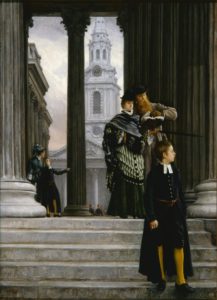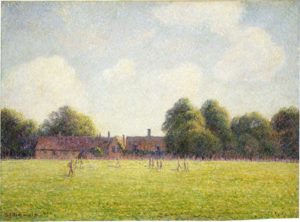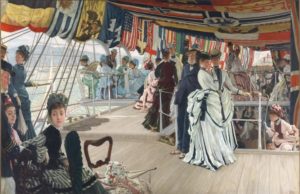
Impressionists in London, Tate Britain’s big Winter show of 2017/18 hasn’t garnered overwhelming approval in the review columns. Nonetheless we went along earlier this week to take a look.
It isn’t a huge, superlative attracting show but it does include some stunning works of art and the social context in which they were produced and it’s not small. So I would say that it is well worth a visit, reviews notwithstanding. The Franco-Prussian war and terrible three-month siege of Paris, when people ate pets, zoo animals and rats¹ for want of anything else, was witnessed by some of the artists e.g. James Tissot was a stretcher bearer with the National Guard. This was followed by the Commune and its eventual bloody repression, in which, it is estimated, 20,000 people died, many in reprisals. Edward Manet tried to draw some of the ‘Civil War’ he saw on the streets, but came close to suffering a nervous breakdown. Gustave Dore painted scenes he had witnessed first hand. Some of their works are on show in Room 1 along with photographs. ‘Disaster tourism’ was born – with Thomas Cook offering trips to see the devastation.
Easy to see, then, why so many artists (and Communards) fled to Britain and London in particular. They met with a thriving art market and an established French ex pat community. There were, as the exhibition points out, no restrictions on entrance – Britain welcomed the thousands of refugees. The Pre-Raphealites, Whistler and Watts welcomed the artists in particular, making introductions, finding them situations and encouraging art dealers to buy their work. Legros, Monet, Pissaro, Sisley and Tissot all settled here, together with others, excellent artists of whom I had not heard until now, like Nittins and Dalou.
Their paintings show how they saw London and the British.
 Pissaro took to cricket and recording scenes which were both industrial and pastoral at the same time. Tissot became a society painter, very reminiscent, to my untutored eye, of Singer Sargeant, who overlapped with the later years of the French residency. His ‘Country Cousins’ (above) showing tourists outside the National Gallery is typical of the way he structures a seemingly spontaneous moment.
Pissaro took to cricket and recording scenes which were both industrial and pastoral at the same time. Tissot became a society painter, very reminiscent, to my untutored eye, of Singer Sargeant, who overlapped with the later years of the French residency. His ‘Country Cousins’ (above) showing tourists outside the National Gallery is typical of the way he structures a seemingly spontaneous moment.
All of them, without exception, seem drawn to the Thames, from Monet’s wonderful canvasses of Westminster in fog at sunrise or sunset, which fill a whole room towards the end of the exhibition, to Pissaro and Sisley painting the river in the centre and at the edges of the city. Then there are Tissot’s pictures aboard the ships at anchor in the Pool. I also stood once more in awe in front of the Whistler Nocturnes, included here because of their influence on the Impressionists and still absolutely some of my favourite artworks.

That the exiles formed a brotherhood of their own is evidenced by the number of portraits on display of one by another, though not the ‘big three’ of Monet, Pissaro and Sisley. There is also a selection of fine, classic sculpture by Carpeaux and Dalou. A word, finally, for Nittins, an Italian by birth but a Parisian by inclination and residency until the War, who was new to me. His city-scape of Piccadilly on a rainy afternoon was very fine indeed and he could do the foggy Thames too. I will keep an eye out for him in future.
The exhibition runs until 7th May 2018 and costs £17.70 to enter. Concessions are available.
¹The French ‘bible’ of cookery first published in 1938, the Larousse Gastronomique still contains an entry for rodent and rat, with reference to the siege ( and later! ). On a personal note, pets of our family , though much loved, were always admonished with the warning ‘Siege of Paris’when misbehaving.
If you enjoyed reading this article you might also enjoy Rainbow Aphorisms Welcome to Saxnot America After the Fall The Life and Death of Miss Dupont


 RSS – Posts
RSS – Posts